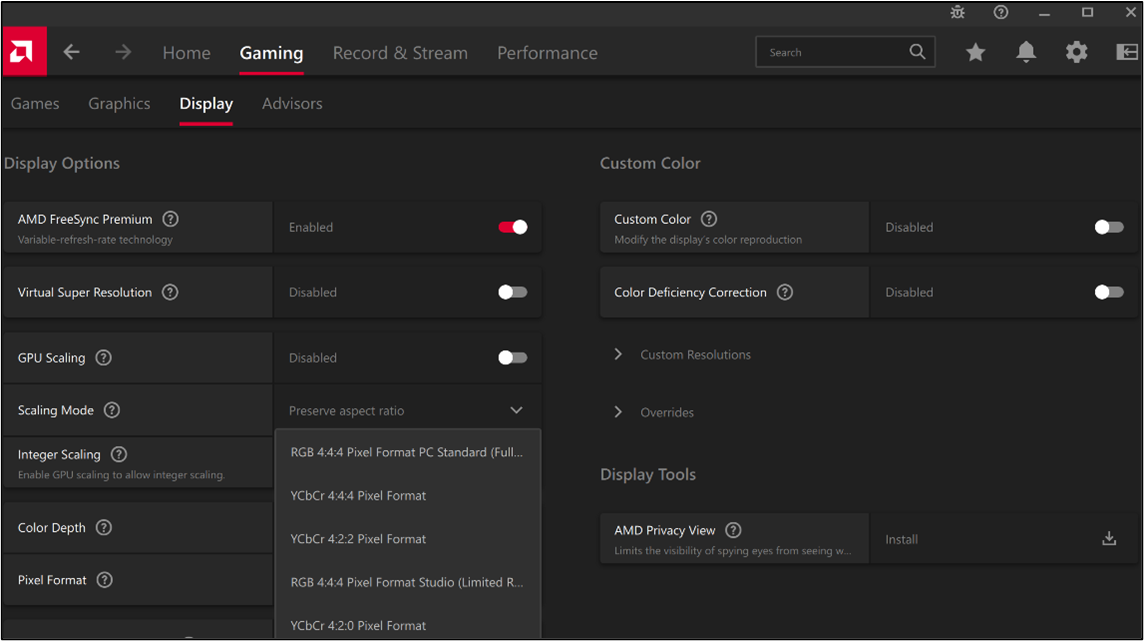Article Number: DH3-007
Last Updated: November 8th, 2024
Overview
DisplayPort (DP) and HDMI™ displays can use one of two different color formats, YCbCr and RGB. These color formats are the digital equivalent found in Component Video (YPbPr) and D-Sub VGA (Video Graphics Array) analog signals.
The YCbCr format contains a subset of color-coding data, also referred to as Chroma Subsampling and represented in the 4:n:n (Y:Cb:Cr) format. The left digit indicates luminance, the middle digit represents the blue channel, and the right digit is the red channel.
The RGB format contains Limited (16-235 bits) and Full (0-255 bits) options which represents the range of the white and black levels that can be displayed.
Compatibility
The following formats are supported with AMD Software: Adrenalin Edition on AMD Radeon™ Series Graphics and compatible displays using direct DisplayPort or HDMI connections (cable adapters and converters are not supported):
- YCbCr 4:4:4 Pixel Format
- YCbCr 4:2:2 Pixel Format
- YCbCr 4:2:0 Pixel Format
- RGB 4:4:4 Pixel Format Studio (Limited RGB)
- RGB 4:4:4 Pixel Format PC Standard (Full RGB)
The format of choice is determined by the source content and video standards & specifications supported by the output display. Since most current displays can automatically convert color code data, using one format over another may have very little to no observable effect to the content produced on-screen. However, depending on the picture mode set on the display, the color in some content may appear washed out. Please consult the display’s user manual for information on supported picture modes and color formats.
Pixel Format Setting
To adjust pixel format setting with AMD Software: Adrenalin Edition, follow these steps:
- From the Taskbar, click on Start (Windows icon), type AMD Software, and select the app under best match.
- In AMD Software, enter "Display" into the search box (highlighted below), and click on the "Display Settings" result displayed.

- Click on the drop-down menu next to Pixel Format and select the preferred setting which will be applied immediately.
NOTE: If there is more than one active display present, make sure to select the desired display.

Note: The screenshot example used in this article is for illustrative purposes only. Depending on your system configuration, some options and settings may not be available to you or exactly as shown in the images. However, the general steps provided are applicable for most systems equipped with AMD Radeon™ Series Graphics and compatible displays.
© 2024 Advanced Micro Devices, Inc. The information contained herein is for informational purposes only and is subject to change without notice. While every precaution has been taken in the preparation of this document, it may contain technical inaccuracies, omissions and typographical errors, and AMD is under no obligation to update or otherwise correct this information. Advanced Micro Devices, Inc. makes no representations or warranties with respect to the accuracy or completeness of the contents of this document and assumes no liability of any kind, including the implied warranties of non-infringement, merchantability or fitness for particular purposes, with respect to the operation or use of AMD hardware, software or other products described herein. No license, including implied or arising by estoppel, to any intellectual property rights is granted by this document. Terms and limitations applicable to the purchase or use of AMD's products are as set forth in a signed agreement between the parties.